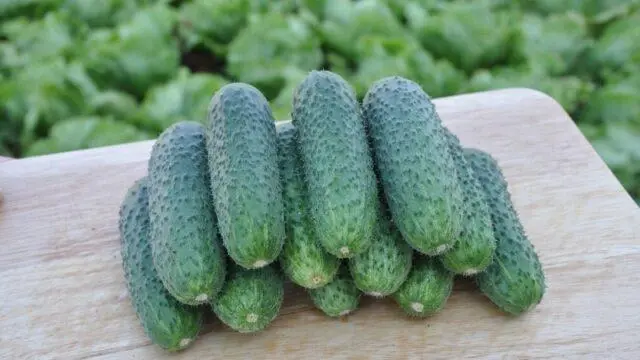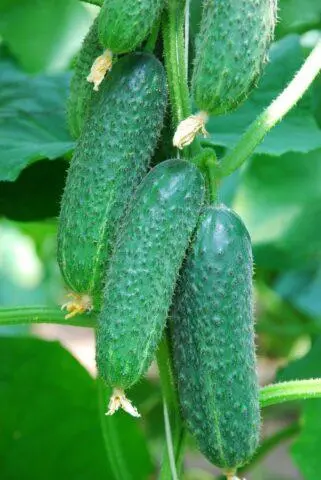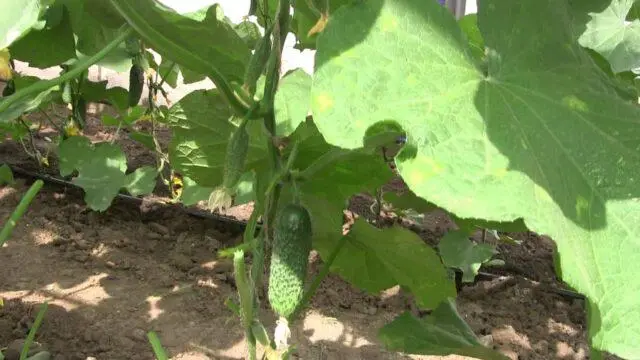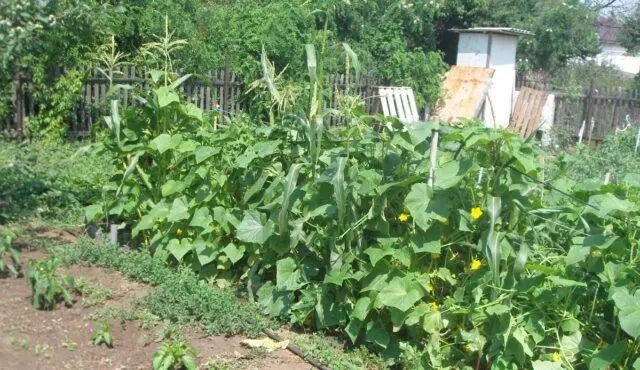Contents
Cucumber Tchaikovsky (Chairjvsriy) is a parthenocarpic vegetable variety that shows good results even without much care for it. In case of making mistakes during cultivation, the variety still pleases the gardener with a tasty and rich harvest. Cucumber has a good presentation, is universal in use, the vegetable can be transported over long distances.

Farmers grow the Chaikovsky variety for subsequent sale to the market
History of occurrence
Cucumber Tchaikovsky was bred in 2013 by specialists from Holland. It is positioned as an improved hybrid of the Kibriya variety. Both of these species were developed by the breeders of the agricultural firm Raik Tswan, but, according to the authors, Tchaikovsky is an improved version.
Description of cucumbers Tchaikovsky F1
A hybrid of this variety of the female type of flowering, perfectly adapted for cultivation in greenhouses and hotbeds. Cucumber Tchaikovsky has small bushes with strong compact stems, growing in length up to 200-250 cm. Lateral shoots, which are able to independently regulate growth, the variety produces in limited quantities. The leaves of the culture are medium-sized, saturated green in color, able to retain moisture for a long time. The variety forms bundle ovaries, three or more fruits are formed in each sinus. They are short, grow in length up to 120 mm, weighing an average of 70-90 g, have the shape of a cylinder, dark green color. The peel of the Tchaikovsky cucumber is covered with tubercles with sharp thorns. The pulp is fleshy and juicy, crispy, sweetish in taste, bitterness is absent.
Characteristics of Tchaikovsky cucumbers
The variety is considered high-yielding, each node can produce up to five simultaneously ripening fruits. Due to the short growing season, you can use the Tchaikovsky cucumber throughout the season, grow both spring-summer and summer-autumn crops. Plants planted in open ground tolerate the vagaries of the weather well, are resistant to heat and cold. If planted late, they can bear fruit until October.
Zelentsy are distinguished by excellent keeping quality; they can be stored in the refrigerator for up to a month. Suitable for salads and fresh consumption. In preservation, they remain crispy and dense.

Strong stems of Tchaikovsky cucumber perfectly cope with the weight of ripening fruits
Productivity
The main advantage of the variety is its high yield. With proper care, up to 50 tons of greens are harvested from a hectare of land. From one square meter throughout the growing season, you can get up to 45 kg of crop.
Ripening and flowering time
30-40 days after sowing, the moment of flowering of the crop comes. About a month and a half after germination, the Tchaikovsky cucumber begins to bear its first fruits. Roughly this occurs from June to September. Cucumbers are removed when their length reaches 10-12 cm.
Disease and pest resistance
Breeders stated that the Tchaikovsky cucumber has a high resistance to such common crop diseases as:
- brown spotting;
- powdery mildew;
- cucumber mosaic.
Average immunity has been developed to anthracnose, peronosporosis, white rot.
Of the pests, melon aphids, spider mites, slugs, and whiteflies can attack the Tchaikovsky variety cucumber.
If any of the above ailments is found, the bushes of the plant should be immediately treated with suitable preparations. After that, it is recommended to carry out preventive measures to avoid re-infection.
Advantages and disadvantages
The Tchaikovsky variety has not yet had time to show its shortcomings, but was able to fully show all the positive aspects.

In the Far East and Siberia, cucumber can only be grown indoors
Advantages:
- fast vegetation;
- self-pollination;
- friendly maturation;
- high yield;
- transportability;
- keeping quality;
- excellent taste without bitterness;
- resistance to temperature extremes;
- strong immunity.
Disadvantages:
- prickly thorns;
- inability to collect seeds;
- increased requirements for the soil.
Planting cucumbers Tchaikovsky
It is not difficult to grow a Tchaikovsky cucumber. If you follow all the rules of agricultural technology, provide the culture with nutritious loose soil and proper care, then the resulting crop will indescribably please the vegetable grower. Planting a plant can be done by seedling or seed method. In the first case, sowing is carried out at the end of April, planting from May to June, in the second case, seeds are sown in May.
Seedbed method
Growing a crop by seedling method makes it possible to harvest an earlier crop. To get strong seedlings, Tchaikovsky cucumber seeds are planted in separate containers, preferably if they are peat pots. A substrate is poured into each cup, moistened, placed on top of one seed, and 1 cm of loose soil is poured. Place the containers on the windowsill, cover them with a transparent film, after the appearance of sprouts, the material is removed. As the top layer of the earth dries up, watering is organized. When four true leaves appear on the sprouts, the Tchaikovsky cucumber is planted in open ground. Planting of young bushes is carried out in a row at a distance of at least 40 cm from each other. During work, small holes are dug, humus is poured into them, moistened, seedlings are placed together with a peat pot and lightly sprinkled with earth.
Sowing in open ground
By seed method, Tchaikovsky cucumber is planted in open ground if they want to get a later harvest. In this case, the fruits will begin to ripen closer to the middle of summer, and their collection will continue until September, and in some regions until October.
A semi-shaded area is allocated under the bed, it is desirable that in the first half of the day it is illuminated by the sun, and in the second it is in the shade. The beds are dug up and fertilized before planting. Seeds are sown in rows according to the scheme 1×0,35 m. Humus is placed at the bottom of the planting hole, 1-2 seeds are placed, covered with soil, and carefully watered.
In order for the harvest to be of high quality, it is advisable to follow the crop rotation. Earlier than four years later, a vegetable cannot be planted in the same place. Also, a distinctive feature of the Tchaikovsky variety is that he does not like dense plantings. If all the seeds sprout, the beds are thinned out, leaving 1 sq. m 4-5 of the strongest sprouts.

In the Far East and Siberia, cucumber can only be grown indoors
Cucumber care Tchaikovsky
A variety of culture is considered a moisture-loving plant, but it should be understood that waterlogging can adversely affect its health. Tchaikovsky cucumber should be watered exclusively under the root, in the evening or early in the morning, with water with a temperature not lower than +10 ° C. Young plants require 10 liters of water per square meter of beds, after the appearance of small fruits, each bush will need this amount of liquid. In hot weather, the beds are often watered, during precipitation, excess moisture is removed by making grooves. After moistening, the soil is loosened, weeds are removed.
For the harvest to be truly rich, the Tchaikovsky cucumber should be fed. For this, they usually use:
- in the fall – ammonium nitrate;
- in spring – complex fertilizers;
- before planting – nitrogen and potassium;
- when three sheets appear – superphosphate and nitrate;
- two weeks later – mullein;
- during flowering – urea and wood ash;
- at the time of fruiting – chicken manure.
The hybrid should be grown on props or trellises, to which the stems are vertically tied. So the plant will develop and ventilate better, and the cucumbers themselves will be more convenient to pick. In an open area, the tops of the bushes are pinched on 4-5 leaves and bred in two sleeves.
Conclusion
Cucumber Tchaikovsky, despite the fact that it was bred relatively recently by breeders, has already managed to win the love of gardeners. The variety can be grown in almost every region; in cold climates, it is successfully bred in greenhouses. Tchaikovsky does not need special care, has good immunity, shows a high yield and has an excellent taste.









